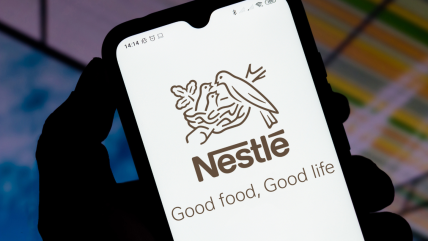
Nestlé anticipates its “real internal growth” will rebound after posting the largest drop since the final three months of 2022 in the opening quarter of this year.
The key RIG metric – which strips out the effect of pricing from organic growth to reflect changes in volume – fell 2% in Nestlé’s opening quarter of 2024. The company pointed to “weakness” in frozen pizza and snacks in the US as low-income consumers turned to private label.
Speaking on her first results call today (25 April) since becoming CFO on 1 March, Anna Manz said Nestlé encountered “intense price competition” in those categories during the quarter, while retailers also cut inventories.
Nestlé’s 2023 exit from the frozen meals segment in Canada also played a part in the RIG downturn, Manz said, describing the metric’s decline as “atypical”.
She added that the first quarter was an “interruption to the steady progress Nestlé has been making on improving RIG”. However, bar the final three months of 2023, the gauge had been negative for five straight quarters.
“The important message here is that this is a temporary issue,” Manz said. “The contributing factors are already correcting, and we expect clear proof of our progress in the second quarter.”
CEO Mark Schneider said Nestlé is “spring loaded for a significant rebound” in RIG, helped by the performance of the so-called billionaire brands such as KitKat chocolate, Purina pet care and Nespresso coffee.
“As we pivot from price to RIG-led growth and the competitive environment changes, our ability to build on the strength of these billionaire brands by maintaining their relevance with consumers will drive growth,” Schneider explained.
“In the first quarter, sales of billionaire brands grew at twice the group average.”
Nevertheless, Nestlé’s organic growth slowed for a fourth consecutive quarter to 1.4% as the effect of pricing faded with cooling inflation. Pricing for the quarter was 3.4%, down from as high as 10% in 2022.
Reported sales stood at SFr22.1bn ($24.1bn), a decrease of 5.9% from a year earlier. Exchange rates had a 6.7% negative impact, while divestitures weighed on sales by 0.6%.
Assessing the trading environment in North America, Schneider said: “In the past few years, we substantially transformed the North American product portfolio.
“This includes a series of strategic acquisitions and divestitures that focused on the structurally more attractive categories and segments and ones in which Nestlé has earned the right to win.”
However, he added: “Following significant food-price inflation, lower-income consumers have led the trend to trading down and buying private label.
“At the same time, much of our portfolio transformation and product development in recent years positioned us well with those US consumers who have a strong and growing interest in premium products.”
Manz, the former Unilever and Diageo executive who joined Nestlé from the London Stock Exchange, suggested consumer demand will improve in the US as the year progresses as results lap last year’s reduction in food benefits under the Supplemental Nutrition Assistance Program (SNAP).
That programme had been “subsidising food purchases for about 40 million Americans”, she said, adding that RIG at the group level will be positive for each of the next three quarters.
Despite the perceived optimism, Nestlé maintained its 2024 organic growth outlook at 4%, and reiterated expectations for a “moderate increase” in the underlying trading operating profit margin. Underlying earnings per share in constant currency will rise 6-10%, unchanged from the previous guide.
RIG fell 5.8% in North America, where pricing was 3.3% and organic growth was a negative 2.5%.
Manz said the combination of inflation and the reduction in SNAP benefits meant low-income consumers in the US had seen a “decrease in purchasing power of about 50%”, which particularly hit the frozen food category.
“The things that make me feel good and why we're seeing improving performance through the quarter is that we've got a very strong innovation pipeline. There's a lot to come particularly on frozen, which is a high innovation category,” she said.
Schneider added that Nestlé’s advertising and market spending will also support volumes going forward.
“We've been essentially on the accelerator since Q2 last year, accelerating all throughout the first quarter,” he said. “We're seeing improving market-share trends, in particular around the billionaire brands, and that is another initiative we have to focus on more strongly.”
Pricing, however, remains in the domain for now with first-quarter increases ranging from 3.3% in North America to 4.6% in Europe.
“We still expect moderate positive pricing for the year 2024,” Schneider said.
“Having said that, with our different cycles of different commodities and input costs in different geographies, pricing going forward will have to be a lot more nuanced than what we had in the past.
“You will see some categories and geographies with continued pricing in a very targeted specific way. And others where we may have to hold steady or even retreat slightly on pricing in order to stay in the game and competitive.”



